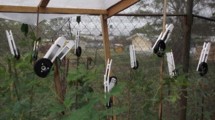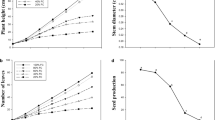Summary
An experiment for differential water supply was set up. The effects of antitranspirants Phosfon-D and CCC on the growth ofVigna unguiculata L. Var K3B grown under suboptimal soil moisture conditions were recorded. An evaluation of the various aspects of growthe.g., seedling survival percentage, shoot growth, root growth, stomatal index and chlorophyll content indicated that application of CCC and Phosfon-D can help withstanding the adverse effects of sub-optimal soil moisture conditions to a certain extent. In the beginning of the paper effects of Phosfon-D CCC and MH on seedling growth are described.
Similar content being viewed by others
References
Adedipe N O, Ormrod D P and Maurer A R 1969 The response of Pea plants to low concentrations of Cycocel, Phosfon and B- nine. Am. Soc. Hort. Sci. 94, 321–323.
Arnon D I 1949 Copper enzymes in isolated chloroplasts. Polyphenoloxidase inBeta vulgaris. Plant Physiol. 24, 1–15.
Babalola O 1980 Water relations of three cowpea cultivars (Vigna unguiculata L.). Plant and Soil 56, 59–69.
Beackbane A B 1961 Structure of the plant stem in relation to adventitious rooting. Nature. 192, 954–955.
Carlson M C 1938 The formation of nodel adventitious roots inSalix cordata. Am. J. Bot. 25, 721–725.
Carlson M C 1950 Nodal adventitious roots in willow stems of different ages. Am. J. Bot. 37, 555–561.
Cathey H M and Pringer A A 1961 Relation of Phosfon to Photoperiod, kind of supplemental light and night temperature on growth and flowering of garden annuals. Proc. Am. Soc. Hort. Sci. 77, 608–619.
Fahn A 1967 Plant Anatomy. Pergamon Press, London.
Gru pce R, Gudeski A and Lozinska E 1968 Anatomica characteristics of wheat stems treated by chlorocholine chloride. Sav., Poljopr. 16, 681–688.
Halevy A H and Kessler B 1963 Increased tolerance of bean plants to soil drought by means of growth retarding substances. Nature London 197, 310–311.
Jung J and Sturm H 1964 The growth regulators, especially chlorocholine chloride (CCC). Lendw. Forsch. 17, 1–9.
Knypl J S 1970 Inhibition of chlorophyll synthesis growth retarding chemicals and coumarin in detached cotyledons of pumpkins. Biochem. Physiol. Pflanz. (BPP). 161, 1–13.
Knypl J S 1973 Effects of growth retarding compounds on chlorophyll accumulation and nitrate reductase activity in nitrate induced cucumber cotyledons. Acta. Soc. Bot. Pol. 42, 431–439.
Kuraishi S and Muir R M 1963 Mode of action of growth retarding chemicals. Plant Physiol. 38, 19–24.
Lockhart J A 1962 Kinetic studies of certain antigibberellins. Plant Physiol. 37, 759–764.
Mayr H H and Barbier S 1964 Stem shortening and secondary effects of some quaternary ammonium compounds when used as disinfectants and fertilizers. Z. Pflanzenernaehr. Dueng. Bodenkd. 106, 39–45.
Murray B E 1957 The ontogeny of adventitious stems and roots of creeping- rooted alfalfa. Can. J. Bot. 35, 463–475.
Ota T 1963. On the effect of growth retardants on salt tolerance and drought resistance in beans. Proc. Crop. Sci. Soc. Japan. 32, 197.
Paquin R, Belzilel L, Wilemot C and Stpierre J C 1976 Effect of various growth retardants and gibberellic acid on the resistance to cold of alfalfa (Medicago sativa). Can. J. Plant Sci. 56, 79–86.
Plaut Z, Halevy A H and Shmueli E 1964 The effect of growth retarding chemicals on growth and transpiration of bean plants growth under various irrigation regimes. Israel J. Agric. Res. 14, 4.
Rao J V S, Subhadra Devi M and Swami P M 1976 Effect of stage of maturity on the chemical composition of oats. Han. J. Res. Hissar. 3, 35–43.
Rodina N A 1971 Application of chlormaquat to spring barley. Trudy Kirovskogo Sel' skohozyal Stvennogo Instituta. Agronomiya. 23, 38–45.
Salisbury E J 1942 The Reproductive Capacity of Plants G Bell and Sons Ltd., London, pp 244.
Sarin M N and Uprety D C 1965 Interactive effects of Phosfon-D, B-Nine, Gibberellic acid and salinity ofVigna unguiculata (L.). ‘Walp’ growth and development of plants pp 187–212. Ed. by Asna and Nanda. Pub. by Today and Tomorrows Book Agency, New Delhi.
Sinha N C, Mehrotra O N and Mathur R K 1980 Cycocel, an antitranspirant and regulant for stomatal closure in dry-land agriculture. Science Culture 46, 100–101.
Srivastava S C and Menon R G 1966 A technique for maintaining constant level of soil moisture in pot culture studies. Curr. Sci. 35, 422–423.
Stuart N W 1961 Initiation and development of flower buds in Rhododendron following application of growth retardants. Plant Physiol. 36, Suppl. liv.
Supniewski J, Supniewska H and Chytkowski A 1962 2-chloroethyl trimethyl ammonium chloride. Bull. Acad. Polon Sci. 10, 393–395.
Yadava R B R and Sreenath P R 1975 Stimulation in seed germination through growth retardants. Curr. Sci. 44, 314–315.
Yadava R B R, Patil B D and Sreenath P R 1978 Effect of growth regulators on leaf growth, photosynthetic pigments and seed yield of burseem (Trifolium alexandrium) L.) Forage Res. 4, 121–125.
Author information
Authors and Affiliations
Rights and permissions
About this article
Cite this article
Agarwal, R.M., Das, R.R. & Chauhan, R.A.S. Growth ofVigna unguiculata L. var. GWL K3B in sub-optimal moisture conditions as influenced by certain antitranspirants. Plant Soil 91, 31–42 (1986). https://doi.org/10.1007/BF02181816
Received:
Revised:
Issue Date:
DOI: https://doi.org/10.1007/BF02181816




